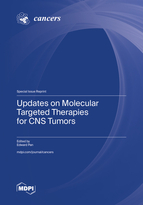Updates on Molecular Targeted Therapies for CNS Tumors
A special issue of Cancers (ISSN 2072-6694). This special issue belongs to the section "Molecular Cancer Biology".
Deadline for manuscript submissions: closed (20 December 2022) | Viewed by 56733
Special Issue Editor
Special Issue Information
Dear Colleagues,
The challenges in identifying effective therapies for CNS tumors continue to be daunting. Potentially effective targeted therapies must be able to penetrate the blood–brain barrier to reach the tumor and, in sufficient concentrations, to result in meaningful treatment responses. Moreover, molecular targets must be key drivers in the growth and progression of CNS tumors. Numerous potentially efficacious therapies have failed in randomized clinical trials due to other factors, including subclonal genetic intratumoral heterogeneity (particularly within malignant gliomas), epigenetic heterogeneity, and failure to target important factors involved in the tumor microenvironment. Developing effective targeted therapies requires a thorough fundamental understanding of the genetic and epigenetic factors driving tumor progression, the interactions between CNS tumor cells and the tumor microenvironment, and the key mechanisms of tumor treatment resistance. In this Special Edition, experts in the field of CNS tumors will highlight the most promising molecular targets in the development of treatments for patients with CNS tumors.
Dr. Edward Pan
Guest Editor
Manuscript Submission Information
Manuscripts should be submitted online at www.mdpi.com by registering and logging in to this website. Once you are registered, click here to go to the submission form. Manuscripts can be submitted until the deadline. All submissions that pass pre-check are peer-reviewed. Accepted papers will be published continuously in the journal (as soon as accepted) and will be listed together on the special issue website. Research articles, review articles as well as short communications are invited. For planned papers, a title and short abstract (about 100 words) can be sent to the Editorial Office for announcement on this website.
Submitted manuscripts should not have been published previously, nor be under consideration for publication elsewhere (except conference proceedings papers). All manuscripts are thoroughly refereed through a single-blind peer-review process. A guide for authors and other relevant information for submission of manuscripts is available on the Instructions for Authors page. Cancers is an international peer-reviewed open access semimonthly journal published by MDPI.
Please visit the Instructions for Authors page before submitting a manuscript. The Article Processing Charge (APC) for publication in this open access journal is 2900 CHF (Swiss Francs). Submitted papers should be well formatted and use good English. Authors may use MDPI's English editing service prior to publication or during author revisions.
Keywords
- CNS tumors
- targeted therapies
- molecular aberrations
- low grade glioma
- glioblastoma
- brain metastases
- meningiomas
- CNS lymphoma
- pediatric brain tumors
- neoplastic meningitis







